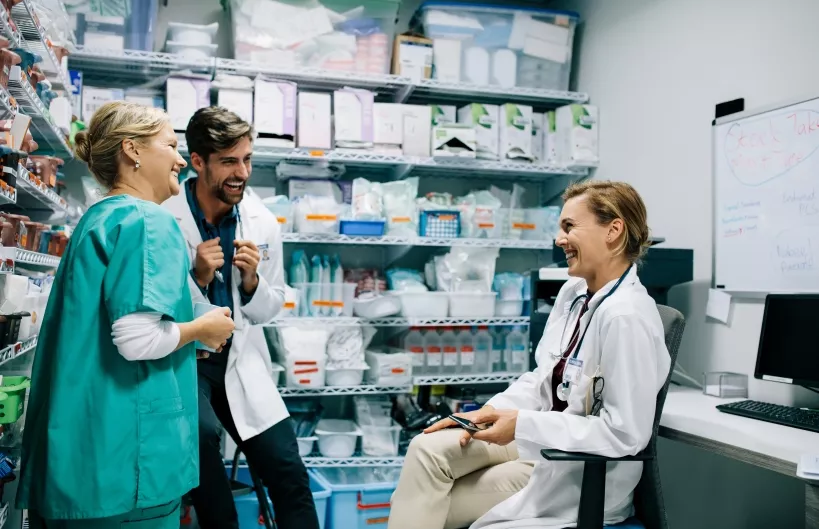Enhancing Efficiency and Addressing Staff Shortages


By Presley Kelleher, VP of Customer Experience and Product, Emporos
Seven out of 10 pharmacies are understaffed1. When a pharmacy is understaffed, every aspect of the business suffers: employees become overburdened, lines are longer, and customer service deteriorates, resulting in patient and employee churn.
Does this situation sound familiar?
Fortunately, there’s a more sustainable solution than the continuous cycle of hiring and training staff – and you’re already familiar with it. Digital transformation, the adoption of online and integrated technology, can bridge the gaps created by staffing shortages to streamline workflows, enhance efficiency, and increase staff capacity.
While the concept sounds nebulous and overwhelming, we’ve identified the most impactful technologies to help you get started on your journey toward modernization.
No. 1: Streamline Transactions with Digital, Self-Service Payments
As a consumer, you use your phone to pay for goods and services nearly daily. From curbside pickup to third-party delivery apps, 82% of Americans use digital payments regularly2.
However, pharmacies and healthcare have been slow to adopt self-service payments due to regulatory concerns. But as dedicated healthcare payment providers have entered the space, it’s now an area ripe for transformation and efficiency gains.
When payments are required to be made at the counter, patients arrive surprised by Rx prices, fumbling with payment methods, and asking pharmacists to update billing information, resulting in lengthy and frustrating transactions. At the most critical point in the patient’s journey, the pharmacist is spending more time with the patient on operational activity rather than clinical engagement. No wonder pharmacies are the second most common place where Americans spend the most time waiting in lines 3.
Providing digital, self-service patient payments via text or email offers patients convenience while saving pharmacy staff time and effort4. Patients can pay how they want, when they want, and where they want, while pharmacists can focus on the core elements of their job. When patients arrive to pick up their prescriptions, pharmacists can verify their identity, see proof of payment with a QR code from the patient, collect the necessary signatures, and offer counseling with little to no billing support required.
Instead of a 10-minute wait time and an ineffective interaction at the register, the pharmacist and patient benefit from shorter, yet more effective interactions.
No 2.: Eliminate Manual Processes with a Mobile Point of Sale (POS) System
Is your staff wasting time using pen and paper? You’re not alone. 71% of providers still use manual processes for collecting payments, signatures, and identification5. This pulls pharmacists and technicians away from their core duties, increases the likelihood of errors, and compromises security.
Manual pen and paper processes are most common during mobile transactions, like meds to beds or curbside pickup, because most point of sale (POS) systems have been reliant on on-premise, hardware-based solutions. But advancements in cloud computing and mobile devices have enabled technology providers to offer mobile, cloud-based systems that work on tablets and laptops without bulky servers.
With a mobile POS that’s integrated with your pharmacy management system (PMS), staff can capture all necessary patient and payment information as the transaction is being conducted6. This enables revenue-driving programs like meds to beds, drive-thru, curbside pickup, and line busting without adding extra workload for your staff. No more frustrating tasks like tracking down signatures with paper, spending hours uploading and scanning, or worrying about accuracy and compliance.
No. 3: Quickly Locate Prescriptions with an Automated Will Call System
In 2021, over 6.5 billion prescriptions were dispensed in the U.S.7 With 66,000 pharmacies in the U.S. that year, we can roughly estimate that each pharmacy handled an average of 98,000 prescriptions annually8.
Think about how long it takes for your staff to find a patient’s prescription during pickup. Even if it only takes a minute, that’s 98,000 minutes—or 1,633 hours (about 2 months)—wasted each year.
An effective, low-cost way to reduce this time is through an automated will call system. These systems use lights and/or sounds to help pharmacists quickly locate prescription bags. When dispensing a prescription, the pharmacist scans the prescription and bag before hanging it on the rack or in the refrigerator. When the patient arrives, the bag lights up or makes a noise, allowing staff to locate it instantly, reducing wait times from 10-30 minutes down to seconds.
While pharmacy automated will-call systems aren’t necessarily new, a lighted will-call system that integrates into the point of sale (POS) is. This helps streamline vendors and applications leveraged by pharmacy staff for greater efficiency.
Reclaim Time to Achieve More with Less
Imagine a pharmacy where your team can focus on what truly matters while experiencing more manageable workloads. Alleviating staffing shortages and providing better patient and employee experiences starts with technology. By doing the work now to modernize your most time-consuming processes, your staff, patients, and bottom line will benefit for years to come.
Self-service payments, mobile POS systems, and automated will call systems are just the beginning. What innovative solutions will you explore next?
Resources
- Untapped opportunities for health system pharmacies | McKinsey (mckinsey.com)
- New trends in US consumer digital payments |McKinsey (mckinsey.com)
- Consumer Survey: The State of Waiting in Line (2023) | Waitwhile
- Pharmacy Payments Pain Points: How to Avoid Them | Emporos
- 2024 Trends in Healthcare Payments Annual Report | J.P. Morgan (jpmorgan.com)
- mPOS: A Patient-Centered Solution | Emporos
- Total drug prescriptions dispensed U.S. 2009-2022 | Statista (statista.com)
Posted originally on Pharmacy Angle: Modernizing Your Pharmacy | PharmacyAngle
